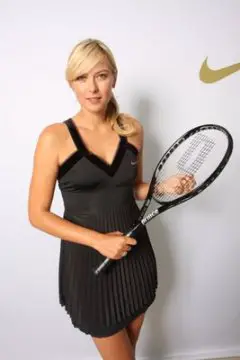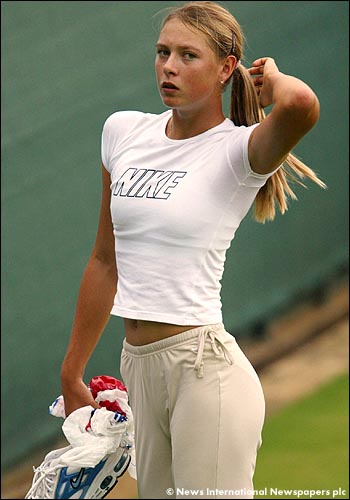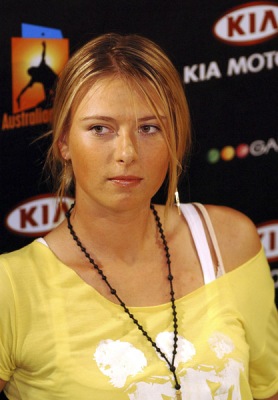Sharapova made her professional breakthrough in 2004 when, at age 17, she upset two-time defending champion and top seed Serena Williams in the 2004 Wimbledon final for her first Grand Slam singles title. She entered the top ten of the WTA Rankings with this win. Despite not winning a major in 2005, Sharapova briefly held the number one ranking, and reached three Grand Slam semifinals, losing to the eventual champion each time. She ultimately won her second major at the 2006 US Open defeating then-World No. 1 Amélie Mauresmo in the semifinals and World No. 2 Justine Henin in the final. Sharapova's 2007 season was plagued with a chronic shoulder injury, and saw her ranking fall out of the top 5 for the first time in two years. She ultimately won her third Grand Slam at the 2008 Australian Open, defeating Henin in the quarterfinals and Ana Ivanović in the final. After reclaiming the number one ranking in May 2008, Sharapova's shoulder problems re-surfaced, ultimately requiring surgery in October and forcing her out of the game for nearly ten months. Sharapova returned in May 2009 and was ranked No. 126 in the world due to her extensive lay-off. Since her comeback, Sharapova has won 3 singles titles (bringing her career total to 22) and recovered her ranking to World No. 12.
Sharapova's public profile extends beyond tennis, as she has been featured in a number of modeling assignments, including a feature in Sports Illustrated Swimsuit Issue. Also she has been featured in many advertisements including Nike, Prince, Canon and many more, also being the face of many fashion houses, primarily Cole Haan. Sharapova was the most searched-for athlete on Yahoo! in both 2005 and 2008. Since February 2007, she has been a United Nations Development Project Goodwill Ambassador, concerned specifically with the Chernobyl Recovery and Development Programme.
Sharapova got engaged to her boyfriend, Los Angeles Lakers guard Sasha Vujačić, after they had been dating for nearly a year.
Contents
* 1 Early life
* 2 Tennis career
o 2.1 2001–03: Professional debut
o 2.2 2004: Breakthrough Season
o 2.3 2005–2006: Consistent results
o 2.4 2007–2008: Injuries and erratic form
o 2.5 2009: Comeback from shoulder injury
o 2.6 2010
o 2.7 2011
* 3 Fed Cup participation
* 4 Playing style
o 4.1 Serve
o 4.2 Surfaces
o 4.3 Ground strokes and Net-Play
* 5 Outside tennis
* 6 Endorsements
* 7 Wealth
* 8 Career statistics and awards
* 9 References
* 10 External links
Early life
Sharapova was born in 1987 to Yuri and Yelena, ethnic Belarusians, in the town of Nyagan' in Siberia, Russia. Her parents moved from Gomel, Belarus after the Chernobyl nuclear accident in 1986 affected the region.[6] When Sharapova was two, the family moved to Sochi where her father befriended Aleksandr Kafelnikov, whose son Yevgeny would go on to win two Grand Slam singles titles and became Russia's first ever World No. 1 tennis player. Aleksandr gave Sharapova her first tennis racket at the age of four, whereupon she began practicing regularly with her father in a local park. took her first tennis lessons with veteran Russian coach Yuri Yutkin, who was instantly impressed when he first saw her, noting her "exceptional hand-eye co-ordination.
At the age of seven, Sharapova attended a tennis clinic in Moscow run by Martina Navrátilová, who recommended professional training at the Nick Bollettieri Tennis Academy in Florida, which had previously trained players such as Andre Agassi, Monica Seles and Anna Kournikova.With money tight, Yuri was forced to borrow the sum that would allow him and his daughter, neither of whom could speak English, to travel to America, which they finally did in 1994. Visa restrictions prevented Sharapova's mother from joining them for two years.[6] Arriving in Florida with just $700 to his name, Sharapova's father took various low-paying jobs, including dish-washing, to fund her lessons until she was old enough to be admitted to the academy. In 1995, she was signed by IMG, who agreed to pay the annual tuition fee of $35,000 for Sharapova to stay at the academy, allowing her to finally enroll at the age of 9.
Tennis career
2001–03: Professional debut
Sharapova first gained attention on the tennis scene in November 2000 when she won the Eddie Herr International Junior Tennis Championships in the girls' 16 division at the age of just 13.She was then given a special award, the Rising Star Award, which is awarded only to players of exceptional promise. She made her professional debut in 2001, and played her first WTA tournament at the Pacific Life Open in 2002, winning a match before losing to Monica Seles. Due to restrictions on how many professional events she could play, Sharapova went to hone her game in junior tournaments, where she reached the finals of the Australian Open and Wimbledon in 2002. She was the youngest girl ever to reach the final of the Australian Open junior championship at 14 years and 9 months
From 2003, Sharapova played a full season, and made a rapid climb into the top 50 by the end of the year.[12] She made her debuts at both the Australian Open and the French Open, but failed to win a match in either.[13] It wasn't until the grass season that she began to fulfill her promise, beating a top 20 player for the first time and reaching her first ever semifinal at the WTA level. Then, as a wildcard at Wimbledon, she defeated 11th seed Jelena Dokić to reach the fourth round, where she lost in three sets to Svetlana Kuznetsova.
By the end of September, Sharapova had already captured her first WTA title, at a smaller event, the Japan Open Tennis Championships, before winning her second in her final tournament of the season, the Bell Challenge. To cap off her first full season as a professional, she was awarded the WTA Newcomer of the Year honor.
2004: Breakthrough Season
Sharapova was defeated in the third round of the Australian Open by seventh seed Anastasia Myskina.[14] The highlight of the remainder of her spring hardcourt season was a run to the semifinals at the Regions Morgan Keegan Championships and the Cellular South Cup, where she ultimately lost to Vera Zvonareva.
During the spring clay court season, Sharapova entered the top 20 on the WTA world rankings as a result of reaching the third round of the Qatar Telecom German Open and the Internazionali BNL d'Italia, both of which were Tier I events. At the latter event, she defeated a player ranked inside the top 10 for the first time with a straight-sets win over World No. 10 Elena Dementieva. Later that clay court season, she went on to make the quarterfinals of a Grand Slam for the first time at the French Open, losing there to Paola Suárez.
Sharapova won the third title of her career at the Wimbledon warm-up DFS Classic, defeating Tatiana Golovin in the final. Seeded 13th and aged 17 at Wimbledon, she reached her first Grand Slam semifinal by defeating Ai Sugiyama. There, she came back from a 6–2, 3–1 deficit to defeat fifth seed and former champion Lindsay Davenport. In the final, Sharapova upset top seed and defending champion Serena Williams to win her first Grand Slam singles title, and become the third youngest woman to win the Wimbledon title, behind only Lottie Dod and Martina Hingis. The victory was hailed as "the most stunning upset in memory",[15] with other writers commenting on her arrival as a serious challenger to the Williams' dominance at Wimbledon. She entered the top ten in the rankings for the first time as a result of the win.
Following her Wimbledon win, attention and interest in Sharapova in the media greatly increased, a rise in popularity dubbed as "Maria Mania."[17] However, on court, she was struggling to achieve results, winning just three of six matches in her preparations for the US Open. At the US Open itself, she reached the third round before being eliminated by Mary Pierce. In order to regain confidence, Sharapova played and won consecutive titles in Asia in the fall, the Hansol Korea Open Tennis Championships and the Japan Open Tennis Championships.
In October, Sharapova defeated Venus Williams en route to making the final of a Tier I event for the first time at the Zurich Open, losing in the final to Alicia Molik. She then made her debut at the year-ending WTA Tour Championships. There, she won two of her three round-robin matches (including a win over US Open champion Svetlana Kuznetsova) in order to advance to the semifinals, where she defeated Myskina. In the final, she defeated Serena Williams 4–6, 6–2, 6–4, after trailing 4–0 in the final set.[14]
 mariya sharapova
mariya sharapova mariya sharapova
mariya sharapova mariya sharapova
mariya sharapova mariya sharapova
mariya sharapova mariya sharapova
mariya sharapova mariya sharapova
mariya sharapova mariya sharapova
mariya sharapovamariya sharapova
 mariya sharapova
mariya sharapova mariya sharapova
mariya sharapova mariya sharapova
mariya sharapova mariya sharapova
mariya sharapova mariya sharapova
mariya sharapova mariya sharapova
mariya sharapova mariya sharapova
mariya sharapova
mariya sharapova


